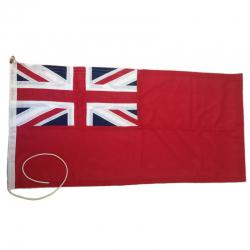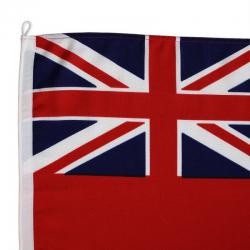Here at Jimmy Green Marine, we frequently encounter questions about who can fly the Red Ensign and where exactly the Red Ensign should be hoisted on a boat. Whether you are setting sail for the very first time, or simply want to dial in on the details of correct flag etiquette, you have come to the right place! Today, our goal is to shed light on any element of mystery that you may be experiencing around the Red Ensign. From here on in, you can hit the open water with confidence, knowing that you have side-stepped any Red Ensign blunders!
What is the red ensign?
Ensigns allow immediate identification of the nationality and country of registry of a vessel on the water. They encapsulate a practice that has been the status-quo for centuries. Red Ensign flags for boats have been around since the early 17th century, but it was in 1707 that Queen Anne established the Red Ensign as the go-to flag for use by the United Kingdom's “loving subjects”. As the United Kingdom grew, the Red Ensign evolved from featuring only the Cross of St George in the upper-left canton, to the Union Jack as we see it today. You may come across the term “Red Duster” used as an alternative to Red Ensign. Both describe this familiar flag, which is the civil ensign for the United Kingdom of Great Britain and Northern Ireland, to be flown by seafaring merchant or passenger ships and leisure yachts and boats
What do we mean by flag etiquette?
To a newbie, flags may seem like an inconsequential detail, but flag etiquette is an important element to master before casting off! The term comprises legal requirements, such as things that you will get in trouble for not doing correctly, but also maritime traditions. Among the seafaring community, a flag-related gaffe may cause some serious confusion, or even offence. If missing the mark on legal obligations, you may be subject to a hefty fine. So, we recommend ensuring your etiquette is on point by getting to know the various flags at your disposal. The Red Ensign is of course the place to start!
Who can fly the red ensign?
When asking who can fly the Red Ensign, it might be better to ask who cannot. This is because for most UK registered vessels, the Red Ensign is a must during daylight hours. The only exception is for those who have been granted permission to fly a special or privileged Ensign. In these cases, you may see Blue Ensigns, White Ensigns, or “defaced” Red Ensigns, which feature the addition of a badge. For those without such permission, wearing anything other than an authorised Ensign is a violation of British and International Law, so definitely to be avoided! If your vessel is not registered, but you and your craft are British, you are entitled and expected to fly the Red Ensign too.
What about lakes, waterways and on dry land?
Ensigns were created to allow easy identification of the nationality of other vessels when at sea, so they are not required when travelling waterways, or on landlocked lakes. However, for those who love proudly displaying their Red Ensign, there is no regulation against hoisting this flag under such circumstances. There are no restrictions on where the Red Ensign can be flown ashore and you may see the flag pop up here and there, particularly at the end of summer. This is because many people fly the Red Ensign on land to celebrate the annual Merchant Navy Day. The campaign calling for landlubbers to hoist the flag was started to remind the British how much we rely on Merchant Navy seafarers for our imports. In fact, sea-bound journeys account for 95% of our imports, including half of the food we eat. What is more, not one of us lives more than 70 miles from the sea. So, fly that Red Ensign with gusto when you are off the water too!
Buying the right red ensign flags for boats
Red Ensign flags for boats should be hoisted in the most senior position for a flag on the vessel in question, which should be as close to the stern as possible. Your Red Ensign should never hang into the water and should not be left to become tatty. If you are purchasing a Red Ensign for your boat, you may have a head-scratching moment trying to figure out what size to buy. Fundamentally, there are no hard-and-fast rules for flag sizing, but guidelines recommend that it should be in proportion to your vessel. Getting this right is a task which falls into the aforementioned etiquette, so is worth giving a little attention! As a rule of thumb, the Red Ensign should measure at a minimum, an inch per foot of yacht. However, to negate the need to start calculating, you will find a handy sizing chart on each of our Red Ensign product pages. Explore the Ensigns we have available and do not hesitate to contact the team here at Jimmy Green Marine should you need further advice.
We would be very happy to assist you!
Main Menu
Main Menu
Back
Main Menu
Back
Main Menu
Back
Back
Main Menu
Back
Main Menu
Back
Back
Main Menu
Back
Main Menu
Main Menu
Back
Main Menu
Back
Back
Back
Back
Back
Back
Back
Back

















